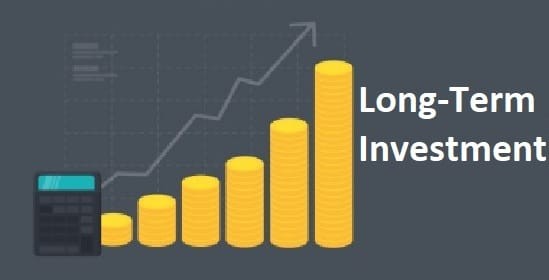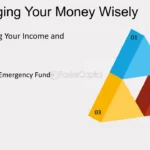Everyone wants to be financially free, to have a life where their money works for them instead of the other way around. For a lot of people, it seems like an impossible goal, like a mountain that is too high to climb. But what if I told you there is a well-known way that has worked for many people to become millionaires? This way is to invest for the long term. It’s not about getting rich quickly; it’s about getting rich for sure. This complete guide will show you how to use the amazing power of long-term investing to make a lot of money and build wealth that will last a lifetime.
The Key to Wealth: Learning About Long-Term Investing
Long-term investing is the act of buying and holding investment assets for a long time, usually five years or more. The goal isn’t to make money off of short-term changes in the market; it’s to let your investments grow and build on each other over time. The idea of “time in the market, not timing the market” is the basis of a good investment philosophy. It’s about having faith in the long-term growth potential of the global economy, being patient, and being disciplined.
The Eighth Wonder of the World: The Magic of Compounding Returns
People often say that Albert Einstein called compound interest the eighth wonder of the world, and they are right. **Compounding returns** are what make long-term investing a good way to build wealth. It’s the process by which the money your investments make starts to make its own money. Over time, this can turn a small initial investment into a huge fortune.
To make this easier to understand, let’s use an example. If you put $10,000 into an investment and it makes an average of 8% a year, you will have $10,800 after the first year. In the second year, you’ll make 8% on all of the $10,800, not just the first $10,000. This means you’ll make $864, which will bring your total to $11,664. It might not seem like much at first, but if you don’t add another cent, that first $10,000 could grow to more than $100,000 over the next 30 years. Now, picture putting money into that investment every year for 30 years. The results can really change your life.
A Real-Life Example: The Story of Two Investors**
Think about Sarah and Tom, two friends. Sarah puts in $5,000 every year for 10 years, starting at age 25 and stopping at age 35. She has put in a total of $50,000. Tom, on the other hand, starts investing at age 35 and puts in $5,000 every year until he retires at age 65. In all, he invests $150,000. If the average annual return is 8%, who do you think will have more money in the end? It’s surprising that Sarah, who only invested for 10 years, will have more money saved up for retirement than Tom, who invested for 30 years. This is what happens when you start saving early and give your money more time to grow. [Investopedia has a great explanation of compound interest at https://www.investopedia.com/terms/c/compoundinterest.asp if you want to know more about this.
Your Financial GPS: The Important Role of Financial Planning
If you start investing for the long term without a plan, it’s like sailing across the ocean without a map or compass. **Financial planning** gives you the structure and direction you need to achieve your financial goals. It’s about knowing where you are now, where you want to go, and making a detailed plan to get there.
How to Set SMART Financial Goals
Setting clear and doable goals is the first step in any financial plan. The SMART framework is a great way to do this:
* **S**pecific: A goal like “I want to be rich” is too vague. A specific goal would be “I want to have a net worth of $1 million by age 60.”
* **M**easurable: Keep an eye on how far you’ve come. How much do you need to save and put away each month to reach your goal?
* **A**chievable: Your goals should be possible given how much money you make and how much you owe.
* **R**elevant: Your financial goals should be in line with your overall life goals.
* Time-bound: Give yourself a deadline for reaching your goal. This makes you feel like you need to act quickly and helps you stay on track.
Budgeting: The Key to Managing Your Money
Setting a budget doesn’t mean limiting yourself; it means giving yourself power. It’s about knowing where your money is going so you can spend it on the things that are most important to you. The 50/30/20 rule is a well-known and useful way to make a budget:
* **50% for Needs:** This includes things like housing, utilities, groceries, and transportation that you need to live.
* 30% for Wants: This is for things you want to do, like going out to eat, having fun, and doing hobbies.
* **20% for Savings and Paying Off Debt:** This is where your investment money will come from.
You can find places to cut back on your spending and free up more money for investing once you have a budget. You can find more information about budgeting at https://www.nerdwallet.com/article/finance/how-to-build-a-budget
The Vehicles of Wealth: Where to Put Your Money
After you make your financial plan, the next step is to pick the best ways to invest your money. Long-term investors should look for assets that have shown they can grow over time.
Stocks (Equities)
When you buy stocks, you own a small part of a company. Your shares can become more valuable as the company grows and makes more money. Individual stocks can be very volatile, but a portfolio of many different stocks has historically given great long-term returns. Warren Buffett, the “Oracle of Omaha,” is a famous investor who made most of his money by owning stocks in fundamentally sound companies for a long time. You can find out more about his ideas on [Berkshire Hathaway’s website](https://www.berkshirehathaway.com/).
Bonds (Fixed-Income)
In a way, bonds are loans you give to a business or the government. You get regular interest payments in return, and at the end of the bond’s term, you get your principal back. Bonds are generally thought to be less risky than stocks and can provide a steady stream of income, which makes them a good choice for a diversified portfolio.
Mutual Funds
Many long-term investors choose mutual funds because they let them spread their money around right away. When you buy a mutual fund, you’re putting your money together with other investors to buy a group of stocks, bonds, or other assets. Professional fund managers take care of them. There are a lot of different kinds of mutual funds, such as
* **Index Funds:** The goal of these funds is to match the performance of a certain market index, such as the S&P 500. They are usually cheap and a good choice for people who want to invest passively.
* **Funds that are actively managed:** In this case, the fund manager buys and sells securities on purpose to try to do better than the market. Most of the time, these funds charge higher fees.
Exchange-Traded Funds (ETFs)
Like mutual funds, ETFs hold a group of assets. But they trade on stock exchanges like regular stocks, so their prices can change during the day. ETFs usually have lower expense ratios than mutual funds and are more flexible. If you want to learn more about ETFs, [Investopedia has a full guide](https://www.investopedia.com/terms/e/etf.asp).
The Power of Diversification
Diversification is based on the saying “Don’t put all your eggs in one basket.” You can lower your overall risk by putting your money into a variety of asset classes (stocks, bonds), industries, and geographic areas. If one part of your portfolio isn’t doing well, another part might be doing well, which will help your returns stay steady over time. A portfolio that is well-diversified is an important part of a long-term investment plan that works.
The Psychology of Investing: Mastering Your Mind
The biggest thing that gets in the way of long-term investing success is often not the market, but us. Fear and greed, in particular, can make us make bad choices that mess up our financial plans. To stay on track, you need to know about and deal with these behavioral biases.
The Risks of Timing the Market
It’s a waste of time to try to time the market by buying at the bottom and selling at the top. It’s almost impossible to do all the time, and when you try, you often end up buying high and selling low. The data shows that some of the best days in the market happen when prices are very unstable. Your long-term returns can be greatly affected if you are not in the market on those days. It’s true that “time in the market, not timing the market.”
Overcoming Behavioral Biases
Loss Aversion: People feel the pain of losing more than they do the pleasure of winning in the same way. This can make investors keep losing investments for too long or sell winning investments too soon. To avoid this, have a set plan for when to sell based on facts, not feelings.
Herd Mentality: People often follow the crowd, which can make them buy into bubbles and sell during panics. Your best defense against this is a well-thought-out investment plan, which is like a GPS for your money.
Confirmation Bias: We tend to look for information that backs up what we already think. This can be bad for your investments. Before making investment decisions, make sure to seek out and challenge opinions that are different from your own.
Behavioral economist Daniel Kahneman’s work is a great place to learn more about the psychology of investing. His book “Thinking, Fast and Slow” has some of his best ideas.
Useful Advice for Your Long-Term Investing Journey
Knowledge is only power in the future. Taking action is what makes it happen. You can start using these useful, actionable tips right away:
Start Now, No Matter How Small
Yesterday was the most important day to start investing. Today is the next best day. You can start investing with as little as $5 thanks to fractional shares and low-cost brokerage platforms. The most important thing is to make investing a habit. You can give more as your income goes up.
Make Your Investments Automatic
Every payday, set up automatic transfers from your checking account to your investment accounts. This “pay yourself first” method makes sure that you are always investing without having to think about it. It stops you from wanting to spend that money on other things and keeps you on track.
Every year, look over your portfolio and make sure it is balanced.
Check your portfolio once a year to make sure that your asset allocation still matches your financial goals and how much risk you are willing to take. You may need to sell some of your investments that have done very well and use the money to buy more of the ones that haven’t done as well in order to keep the level of diversification you want. This is called rebalancing.
Keep Learning
The world of money is always changing. Promise yourself that you will keep learning. Read books, follow reputable financial blogs like Ben Carlson’s [A Wealth of Common Sense](https://awealthofcommonsense.com/), and keep up with what’s going on in the economy. The more you know, the more sure you will be about your investment choices.
Conclusion: Your Future Self Will Thank You
Long-term investing is not a way to get rich quickly. It’s not a sprint; it’s a marathon. It takes time, discipline, and a long-term view. But the benefits are beyond measure. You can use the amazing power of compounding returns to create a future of financial security and freedom by starting early, being consistent, and sticking with it. To start a journey of a thousand miles, you must take one step. Do that step today. Your future self will be grateful.
**Note:** This blog post is only for information and should not be taken as financial advice. Before you make any investment decisions, you should talk to a qualified financial advisor.
Frequently Asked Questions (FAQ)
**Q: How much money do I need to start investing?**
A: You can invest with just a little bit of money. Many brokerage firms don’t require a minimum amount to open an account, and you can buy a piece of a stock for as little as a few dollars with fractional shares. Starting and sticking with it are the most important things.
**Q: What is the best long-term investment?**
A: There isn’t just one “best” investment. Your personal financial goals, how much risk you’re willing to take, and how long you want to invest will all affect the best investment strategy for you. Many long-term investors find that a diverse mix of low-cost index funds or ETFs is a great place to start.
**Q: How often should I look at my investments?**
A: Long-term investors should generally avoid checking their portfolios too often. Watching short-term market changes too closely can make you make decisions based on your feelings. A review every three months or once a year is usually enough to make sure your portfolio is on track.
**Q: Is it too late for me to start putting money into stocks?**
A: You can always start investing. Starting early is the best way to take advantage of compounding, but starting later is still better than not starting at all. Every dollar you put into something has the chance to grow over time.




